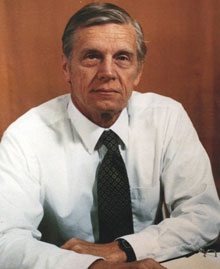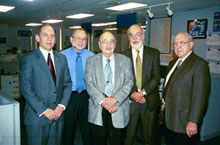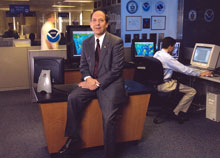A Legacy of Predicting Weather and Climate Events
Using high-speed computers to model, analyze, and deliver data and information related to future weather, climate, and ocean events is the job of forecasters and scientists at NOAA's National Centers for Environmental Prediction (NCEP). From the Sun to the sea, NCEP is where America's weather, climate, and ocean services begin.
A survey of a few articles reveals a common thread...
August 1, 2006 — The national forecast from the NOAA Hydrometeorological Prediction Center calls for very hot temperatures to persist Wednesday through Thursday across much of the East with near record heat in parts of the mid-Atlantic and Northeast before temperatures return to near seasonable on Friday.
September 9, 2005 — Forecasters at the NOAA Space Environment Center in Boulder, Colo., continue to observe significant flares on the sun Friday in NOAA sunspot Region 808...NOAA cautions satellite and communications groups already experiencing problems due to this activity. Other agencies impacted by space weather are at increasing risk for service disruptions.
August 2, 2005 — A very active Atlantic hurricane season is underway, and with more storms projected, NOAA's Climate Prediction Center today increased the number of storms in its 2005 hurricane season outlook.
What do these and other articles like these have in common? They all reveal future weather, climate, and ocean outlooks based on forecasts made at NOAA's National Centers for Environmental Prediction (NCEP).

The Space Environment Center, located in Boulder, Colorado, is responsible for issuing space weather forecasts for the country. Click image for larger view.
NCEP, an organization within NOAA's National Weather Service, is at the central core for national forecasts and even international information. NCEP's mission is to deliver national and global weather, water, climate, and space weather guidance, forecasts, warnings, and analyses to the public. These products and services ultimately help to protect life and property, enhance the nation's economy, and support the country's growing need for weather and climate information. "Everything the public hears, sees, or reads about weather, climate, and ocean prediction starts at NCEP," said NCEP Director Dr. Louis Uccellini.
This article explores how the role of NCEP has evolved since its inception, considers the impact of NCEP's achievements to the nation, and looks to the future of weather and climate prediction.
NCEP's Role in History

Dr. George Cressman was the first Director of the Numerical Meteorological Center, a position he held from 1954-1964. In 1965, Dr. Cressman was named Chief of the Weather Bureau and supervised the transition of the Weather Bureau to the National Weather Service following the creation of NOAA in 1970.
Although weather forecasting dates back centuries, NCEP's origins can be traced back to 1954, when the Joint Numerical Weather Prediction Unit (JNWPU) was formed from elements of the U.S. Air Force, Navy, and Weather Bureau to explore the use of computers for weather forecasting.
Prior to the development of computers and communications technology, forecasters relied on observations of the weather around them. Meteorologists plotted these observations on charts and used the history of past observations to track weather systems' future movements. The process was very time consuming and often wrong.
The JNWPU pioneered developments in numerical weather prediction, or what we call today weather/climate computer models. These models use advanced math and physics to depict and predict atmospheric and oceanic conditions that produce weather. As computers became more powerful and models became more sophisticated, weather forecasters' ability to plot the movements of the atmosphere became increasingly more accurate.
Success in the early days of numerical weather prediction led to a refocusing of approaches within the United States by separating defense application from civilian application. In 1958, the civilian part of the JNWPU became the National Meteorological Center (NMC), a division within the National Weather Bureau. In 1995, the NMC was reorganized and renamed the National Centers for Environmental Prediction.

During its history, NCEP has had five directors and two long-term acting directors. Click image for larger view and full caption.
Over the next 40 years, with increased sophistication in computing and advancements in weather and climate modeling, the organization acquired functions that now include aviation, national weather, space weather, hurricane, ocean, severe weather, and climate forecasting, and more. Forecasts have become increasingly accurate, leading to unprecedented use in decision-making for businesses, emergency managers, and aviation and energy communities.
Today, there are seven NCEP operational service centers: the Climate Prediction Center; Hydrometeorological Prediction Center; Ocean Prediction Center; Storm Prediction Center; Tropical Prediction Center/National Hurricane Center; Aviation Weather Center; and most recently, the Space Environment Center was added in 2005. These service centers are supported by two core centers: the Environmental Modeling Center and NCEP's Central Operations—which provides needed technology infrastructure. The core centers enable the operational service centers to meet their mission of delivery of high-quality products and services on a reliable basis.
NCEP's Impacts and Achievements to the Nation…
Over the years, NCEP has celebrated many great achievements. Its impact and achievements have saved lives and provide a firm foundation to launch many more exciting endeavors. Some of its most recent advancements include:
- Establishing numerical models as the core of the forecast process;
- Using models while relying on forecasters' abilities to improve those models to deliver credible weather forecasts at five-day, then seven-day intervals;
- Delivering reliable seasonal hurricane outlooks as well as increasing the accuracy of hurricane track forecasts three, four, and five days in advance;
- Predicting severe weather outbreaks and making severe weather outlooks one, two, and three days in advance and now with an experimental four- to eight-day forecast;
- Introducing the Climate Forecast System, the nation's first operational atmosphere-ocean coupled model;
- Executing a 99.99 percent on-time delivery of model output to users and the public;
- Implementing forecasts for storms over the ocean with hurricane force winds out to four days in advance based on a global observing system;
- Leasing instead of purchasing NOAA's climate and weather supercomputer; and
- Accelerating model implementations, such as the:
- North American Ensemble Forecast System, a multi-national model approach and partnership with Canada and Mexico;
- Weather Research and Forecasting Model, the first model to serve as both the backbone of the nation's public weather forecasts and as a tool for cutting-edge weather research; and
- Short Range Ensemble Forecast System, which is now becoming a maintain stay for short-range forecasts.
These are just a few of the foundational achievements made over the last 50 years. NCEP continues to push the envelope for solutions that are at the heart of its mission: to protect life and property, enhance the nation's economy, and support the country's growing need for weather and climate information. Every year, new strategic goals are identified for each center and NCEP’s Office of the Director has the responsibility for directing and planning the overall science, technology, and operations behind these efforts.

This map shows the location of the nine NCEP centers. Click image for larger view and full caption.
Yet, behind all of our achievements are the forecasters and scientists who make success possible. While the demand is increasing for more and more automated products, the men and women who produce space, weather, climate, and ocean forecasts will always play an important and vital role. These forecasters are able to diagnose the model output in real time and, when the models go astray, they understand why and rapidly adjust the forecast to enhance performance. NCEP forecasters are able to explain the predictions to user communities and answer the phone when the media wants to know, "Are you sure we are going to get this big event?" NCEP forecasters are an integral part to delivering accurate forecasts to the public.
NCEP Today

Dr. Louis W. Uccellini, director, National Centers for Environmental Prediction and the National Weather Service's winter weather expert. Click image for larger view and full caption.
In today's academic and operational weather prediction communities there is an increasing recognition of the importance for organizations that can handle the transition from research to operations. This means taking results from theory and accelerating their application to "real life" climate, weather, and ocean events.
"It's pretty clear that people probably felt [transferring research to operations] was important, but didn't really know how to do it nor were the resources available to make it happen," said Dr. Uccellini. NCEP is uniquely positioned to facilitate the transition from research to operations. "In the past, people estimated that it took anywhere from seven to ten years to make these changes," said Uccellini. By testing new research within an "operational" framework, NCEP and the research community are obtaining operationally relevant results within six months to a year.
"[It] is just good business practice to accelerate improvements in the forecasts that we can deliver to the entire country and all the citizens in the country," said Brig. Gen. David L. Johnson, U.S. Air Force (Ret.), director of NOAA's National Weather Service. Such delivery is also important in helping scientists and meteorologists design next-generation systems.
The Future of Weather, Climate, and Ocean Prediction

In 2008, the NOAA Center for Weather and Climate Prediction will open at the University of Maryland-College Park. Click image for larger view.
NCEP's mission has not changed, although it has definitely expanded over the years. Today's NCEP represents a central point for predictive services from the Sun to the sea.
Yet, as with weather, change is constant. In the future, NCEP will become more environmental in nature, meaning forecasters will need to consider the ecosystem and management when making predictions. Also, since NCEP's forecasts and products have become extremely important to decision makers across government, the private sector, the media, and other communities and industries, these groups will have an increasing influence on the organization and how it provides information and forecasts to public.
NCEP recognizes that its past, current, and future successes rest on the shoulders of all of its employees and partners and salutes them for their dedicated public service.
Contributed by Carmeyia Gillis, NOAA's National Weather Service
